Maast
Compulsive Tinkerer
Summary: I ran a series of 6 full charge/discharge tests with/without active balancing and/or with/without adding capacity. The BYD module I tested had 1 badly undercapacity and one moderately undercapacity cell and has a unmodified 3.2kwh capacity.
At a 1700W discharge rate with only active balancing the active balancing was completely unable to keep up and added nothing to the pack capacity - but under a low 200W discharge with active balancing it added 200watt-hours to the pack capacity - going from 3.2kwh to 3.4kwh overall capacity. BTW, at the bottom with the weakest cell at 2.9v and the other cells .15 or more higher active balancing was only contributing 1.2A (about 3.5 watts)
When I added two 8AH headways to the weakest cell (cell 6) and one headway to the next weakest cell (cell 4) at a 1700W discharge with NO active balancing the overall pack capacity gained 500wh going from 3.2kwh to 3.7kwh even though the Headways only contributed 76watt-hours to the pack capacity. With active balancing and Headways it added nothing, but the pack was in slightly better balance all along the spectrum of discharge.
For all the tests I charged the module up to 27.6V (3.45v/cell) and kept voltage applied until the charge acceptance went to 0 amps and then discharged to 2.9v at the lowest cell. Unfortunately not all the photos I took of the displays were usable. I'd love to give you the exact amp hours but the screwball DROK meter I'm using wouldnt reset its AH count and turning it off/on and charging/discharging confused the hell out of it. I could only reset the KWH meter, which I decided was good enough.
My test rig, a 20A Meanwell PSP-600-27 as a CC/CV charger, a 12v power supply to drive the relays and displays, 9 QNBBM 1S active balancers, and a 11 year old Victron 3000 feeding a space heater.
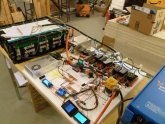
Test 1 - No Active Balance, bare module only, 1700W discharge. Pack capacity 3.2kwh,
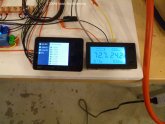
Test 2 - Active balance only, 1700W discharge. Pack capacity 3.2kwh If you click on the picture you'll see the details.
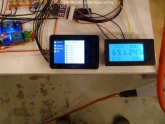
Test 3 - 1700W load, 1 Headway on cell 6, 1 on cell 4. Active balance on. Pack capacity 3.5 khw
Test 4 - 1700W load, 2 HW on cell 6, 1 on cell 4. No Active balance. Pack capacity 3.7kwh. Added 500wh to capacity. I call that a result!

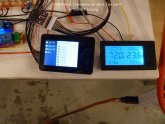
Test 5 - 1700W load 2HW on cell 6, 1 on cell 4. Active Balance on. Pack capacity 3.7kwh but I did notice that the balance was better across spectrum of discharge: 50mv vs 120mv difference. I noticed that after this many charge/discharge cycles that the top balance was MUCH better than when I started. The first cycle the lowest (cell 1) was at 3.39v while the highest (cell 7) was at 3.5v.
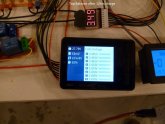
Test 6 - 200W load, Active Balance only. Pack capacity 3.4kwh, added 200wh to capacity.

At the end of the test I measured the balance current and at ~.15v difference than its neighbors it was 1.2A
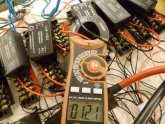
I noticed that in the middle of the discharge curves the active balancers kept the cells usually within 14-20mv of each other until they hit the top or bottom of the charge/discharge cycle.
I actually did a few more charge/discharge cycles that I didnt document here playing around with adding HWs to different cells and other things, about 8 in total.
All the modules I've looked at so far have been badly out of balance throughout the spectrum of charge and discharge, Usually with 1 sometimes 2 undercapacity or very undercapacity cells randomly distributed with a slight preference to the second half of the module (cells 4-8)
With these results, and the other things I've done with the BYD modules IMO the best way to use these is to parallel multiple packs at the cell level, add capacity to the lower cell groups, and use a robust active balancer. I'd NEVER use just one bare module unless I'd spent a good bit of time carefully adding capacity to the undercapacity cells until it was balanced all along the spectrum of charge/discharge while using a active balancer.
Edited a few times for typos.
At a 1700W discharge rate with only active balancing the active balancing was completely unable to keep up and added nothing to the pack capacity - but under a low 200W discharge with active balancing it added 200watt-hours to the pack capacity - going from 3.2kwh to 3.4kwh overall capacity. BTW, at the bottom with the weakest cell at 2.9v and the other cells .15 or more higher active balancing was only contributing 1.2A (about 3.5 watts)
When I added two 8AH headways to the weakest cell (cell 6) and one headway to the next weakest cell (cell 4) at a 1700W discharge with NO active balancing the overall pack capacity gained 500wh going from 3.2kwh to 3.7kwh even though the Headways only contributed 76watt-hours to the pack capacity. With active balancing and Headways it added nothing, but the pack was in slightly better balance all along the spectrum of discharge.
For all the tests I charged the module up to 27.6V (3.45v/cell) and kept voltage applied until the charge acceptance went to 0 amps and then discharged to 2.9v at the lowest cell. Unfortunately not all the photos I took of the displays were usable. I'd love to give you the exact amp hours but the screwball DROK meter I'm using wouldnt reset its AH count and turning it off/on and charging/discharging confused the hell out of it. I could only reset the KWH meter, which I decided was good enough.
My test rig, a 20A Meanwell PSP-600-27 as a CC/CV charger, a 12v power supply to drive the relays and displays, 9 QNBBM 1S active balancers, and a 11 year old Victron 3000 feeding a space heater.

Test 1 - No Active Balance, bare module only, 1700W discharge. Pack capacity 3.2kwh,

Test 2 - Active balance only, 1700W discharge. Pack capacity 3.2kwh If you click on the picture you'll see the details.

Test 3 - 1700W load, 1 Headway on cell 6, 1 on cell 4. Active balance on. Pack capacity 3.5 khw
Test 4 - 1700W load, 2 HW on cell 6, 1 on cell 4. No Active balance. Pack capacity 3.7kwh. Added 500wh to capacity. I call that a result!


Test 5 - 1700W load 2HW on cell 6, 1 on cell 4. Active Balance on. Pack capacity 3.7kwh but I did notice that the balance was better across spectrum of discharge: 50mv vs 120mv difference. I noticed that after this many charge/discharge cycles that the top balance was MUCH better than when I started. The first cycle the lowest (cell 1) was at 3.39v while the highest (cell 7) was at 3.5v.

Test 6 - 200W load, Active Balance only. Pack capacity 3.4kwh, added 200wh to capacity.

At the end of the test I measured the balance current and at ~.15v difference than its neighbors it was 1.2A

I noticed that in the middle of the discharge curves the active balancers kept the cells usually within 14-20mv of each other until they hit the top or bottom of the charge/discharge cycle.
I actually did a few more charge/discharge cycles that I didnt document here playing around with adding HWs to different cells and other things, about 8 in total.
All the modules I've looked at so far have been badly out of balance throughout the spectrum of charge and discharge, Usually with 1 sometimes 2 undercapacity or very undercapacity cells randomly distributed with a slight preference to the second half of the module (cells 4-8)
With these results, and the other things I've done with the BYD modules IMO the best way to use these is to parallel multiple packs at the cell level, add capacity to the lower cell groups, and use a robust active balancer. I'd NEVER use just one bare module unless I'd spent a good bit of time carefully adding capacity to the undercapacity cells until it was balanced all along the spectrum of charge/discharge while using a active balancer.
Edited a few times for typos.
Last edited:







